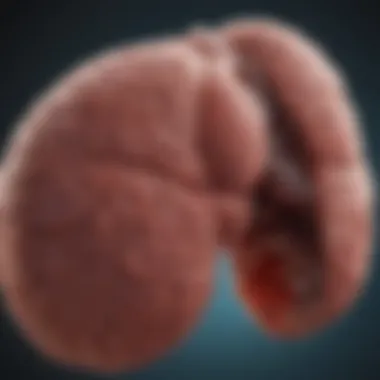Is Liver Cancer Hereditary? An In-Depth Examination


Intro
Liver cancer is a significant health concern around the world. Understanding its causes is crucial for prevention and treatment. One of the most complex discussions centers on the potential hereditary nature of this disease. Does a family history increase individual risk? Or are other factors, such as environmental and lifestyle choices, more determinant?
This article explores these questions by analyzing research findings and expert insights. It focuses on genetic predispositions, lifestyle impacts, and the intertwining of these elements, aiming to provide readers with a well-rounded perspective on the hereditary aspects of liver cancer.
Key Findings
Major Results
Research highlights a multifactorial approach to liver cancer. Various studies have shown that:
- Certain genetic mutations can increase susceptibility to liver cancer.
- Family history plays a role, especially where conditions like hepatitis B and C are prevalent.
- Environmental exposures, such as aflatoxins and alcohol, also contribute significantly to the risk.
Discussion of Findings
The relationship between genetics and liver cancer is complex. Some studies indicate that people with a history of liver disease in their families may have a higher chance of developing the disease themselves. Genetics can influence factors such as metabolism and immune response, which can be critical in cancer development. However, many experts also emphasize that lifestyle choices should not be overlooked. Poor dietary habits, increased alcohol consumption, and exposure to harmful substances can dramatically increase the risk of developing liver cancer, independent of genetics.
"Genetic predisposition certainly plays a role, but it's essential to consider the broader context of lifestyle and environmental influences," says Dr. Smith, a leading oncology researcher.
Methodology
Research Design
The article synthesizes data from various qualitative and quantitative studies focused on liver cancer. Key research findings have been gathered from peer-reviewed journals, expert interviews, and credible health organizations.
Data Collection Methods
Data was collected using:
- Systematic reviews of existing literature on liver cancer and hereditary traits.
- Interviews with oncologists and genetic counselors specializing in hepatic malignancies.
- Analysis of case studies linking family history to the incidence of liver cancer.
By examining these facets, this article aims to provide clarity on the hereditary aspects of liver cancer and the implications for those at risk.
Prolusion to Liver Cancer
Liver cancer is a significant health concern that affects millions of people worldwide. Understanding the nature of this disease is crucial for both prevention and treatment. This section serves as a foundation for exploring the various aspects of liver cancer, including its types, prevalence, and risks associated with hereditary factors. Knowledge of liver cancer can facilitate early diagnosis and improve outcomes.
Overview of Liver Cancer
Liver cancer primarily refers to the malignant growth of cells within the liver. This condition can arise from several underlying issues, such as chronic hepatitis or cirrhosis. It is important to accurately identify the type of liver cancer as this influences treatment strategies and prognosis. Symptoms often include abdominal pain, jaundice, and unexplained weight loss. Early detection directly impacts survival rates, making awareness crucial.
Types of Liver Cancer
Primary liver cancer
Primary liver cancer originates in the liver cells themselves. The most common form is hepatocellular carcinoma, which accounts for approximately 75% of all cases. This type often develops in individuals with chronic liver disease, particularly those with hepatitis B or C infections. The uniqueness of primary liver cancer lies in its direct relation to liver health. Treatment options typically include surgical resection, liver transplantation, or targeted therapies. However, the aggressive nature of this cancer often complicates early intervention.
Secondary liver cancer
Secondary liver cancer, also known as metastatic liver cancer, occurs when cancer cells spread to the liver from other body parts. Common primary sites include the colon, lung, or breast. This type poses a challenge in terms of treatment options, as the focus shifts from the liver to the primary tumor's management. One key characteristic of secondary liver cancer is its indication of advanced disease. Patients often present with less favorable prognostic outcomes due to the extensive nature of metastasis. Addressing secondary liver cancer requires a comprehensive approach, often integrating systemic therapies to manage both the liver and the primary cancer effectively.


Global Prevalence of Liver Cancer
The global prevalence of liver cancer has been rising, with significant geographical variations observed. Regions such as East Asia and sub-Saharan Africa report higher incidence rates due to prevalent risk factors like hepatitis viruses. According to reports by the World Health Organization, liver cancer ranks as one of the leading causes of cancer-related deaths. It is crucial to acknowledge these trends as they underscore the importance of research and awareness efforts aimed at combating this disease.
Understanding the diversity in liver cancer types, along with its prevalence, sets the stage for delving deeper into the hereditary aspects and risk factors in subsequent sections. It brings to light the significance of diagnosing liver cancer early and recognizing its potential hereditary components.
Understanding Heredity and Genetics
Understanding heredity and genetics is crucial in assessing the hereditary nature of liver cancer. This knowledge provides insight into how genetic predispositions and familial patterns can influence cancer risk. By exploring these concepts, we can comprehend how liver cancer might be inherited and the implications for individuals with a family history of the disease.
Definition of Heredity
Heredity refers to the process by which traits and characteristics are passed from parents to their offspring through genes. In the context of liver cancer, this means that certain genetic predispositions may be inherited, increasing the risk of developing the disease. Understanding heredity helps in identifying individuals who are at higher risk, allowing for targeted screening and preventive measures.
Genetics Explained
Genetics play a significant role in cancer development, including liver cancer. The study of genetics encompasses how genes function, how they can mutate, and how these changes can lead to cancer.
Role of genes in cancer
The genes responsible for regulating cell growth and function have a profound impact on cancer. Mutations in these genes can disrupt normal cellular processes, leading to uncontrolled growth and tumor formation. The presence of specific genetic markers can signal an increased risk for liver cancer. Therefore, the relationship between genes and cancer risk is a vital area of research, helping to unravel how hereditary factors contribute to this disease.
Mutation and cancer development
Mutations are changes in the DNA sequence of a gene. They can be inherited or acquired during a person's lifetime. Certain mutations are directly associated with the development of liver cancer. These mutations may lead to the production of abnormal proteins that encourage cancer cell growth. Understanding how mutations contribute to liver cancer is essential for developing diagnostic tools and targeted therapies. Furthermore, analyzing mutations assists in determining the potential hereditary nature of this cancer, providing key information for at-risk individuals.
Investigating the Hereditary Aspect of Liver Cancer
Understanding whether liver cancer has a hereditary component is crucial for several reasons. First, identifying familial patterns can aid in recognizing high-risk individuals who may benefit from early screening and proactive health measures. Moreover, exploring genetic backgrounds provides insights into the mechanisms that underlie cancer development. This knowledge can be instrumental in both prevention and treatment approaches.
Familial Patterns in Liver Cancer
Familial clustering of liver cancer refers to the observation that certain families have a higher incidence of this disease. Studies have shown that individuals with a family history of liver cancer have a greater risk compared to those without such histories. This suggests that genetic predispositions may play a significant role. The generational transmission of risk factors—whether through shared environment or genetic makeup—may also vary between different populations. Investigating these patterns helps to delineate which families should be monitored more closely for potential liver cancer development.
Case Studies and Research Findings
Numerous case studies highlight the relationship between heredity and liver cancer. Research consistently indicates specific genes that might influence susceptibility, including those involved in metabolic processes. For example, the TP53 gene is known for its role in tumor suppression. Mutations in this gene not only elevate the risk of liver cancer but also link familial occurrences. Furthermore, meta-analyses of various studies reveal a connection between hereditary liver cancer and conditions such as cirrhosis, emphasizing the critical need for further investigations into these associations.
Genetic Syndromes Associated with Liver Cancer
Genetic syndromes can significantly impact the risk of developing liver cancer. Two notable conditions associated with this cancer type are Hereditary Hepatocellular Carcinoma and Hereditary Non-Polyposis Colorectal Cancer.
Hereditary Hepatocellular Carcinoma
Hereditary Hepatocellular Carcinoma is primarily characterized by its strong association with genetic mutations. This condition is notably beneficial for discussions on hereditary cancer, as it emphasizes how inherited factors can lead to liver cancer. A key characteristic of this syndrome is its increased likelihood of developing the disease at a younger age, often in individuals under 40. This highlights the urgent need for genetic screening in families with known cases, allowing for early detection and management. The unique feature of this hereditary condition lies in its direct correlation with certain genetic defects, providing a clearer pathway for research and intervention.
Hereditary Non-Polyposis Colorectal Cancer
Hereditary Non-Polyposis Colorectal Cancer, while primarily associated with colorectal issues, also increases the risk for liver cancer. This particular syndrome is significant because it indicates that individuals with a family history of this type of cancer should also consider liver cancer risks. The key characteristic is the mutated mismatch repair genes, which complicate the body's ability to correct DNA mistakes. A unique aspect of this syndrome is that it can lead to a range of cancers, not just limited to the liver or colon. Thus, understanding this connection broadens the scope of preventive measures and tailored treatment plans, which is crucial in addressing hereditary risks.
Investigating these genetic syndromes not only unveils potential risk factors but also paves the way for improved screening and therapeutic strategies.
Risk Factors for Liver Cancer


Understanding the risk factors for liver cancer is essential in grasping the complexities of this disease. An individual's likelihood of developing liver cancer can be influenced by a variety of variables, both genetic and environmental. Recognizing these risk factors can lead to more effective preventative strategies. The relationship between these factors and liver cancer development is critical for at-risk individuals. Certain genetic predispositions can heighten the chances of liver cancer, while environmental influences and lifestyle choices can also significantly affect overall risk. Therefore, addressing these risk factors provides a clear understanding of how to engage in proactive health measures.
Genetic Risk Factors
Genetic risk factors pertain to inherited traits that may increase the likelihood of developing liver cancer. Through research, it has been established that certain gene mutations can play a pivotal role in the susceptibility to this disease. For instance, variations in the TP53 gene are associated with a higher incidence of liver cancer. These mutations can disrupt normal cell cycle regulation, potentially leading to uncontrolled cell growth. Observing family history is important as it may reveal patterns linked to liver cancer, thereby assisting in risk assessment.
Environmental Influences
Chronic Viral Hepatitis
Chronic Viral Hepatitis poses a significant risk for the development of liver cancer. Infections like Hepatitis B and Hepatitis C can lead to long-term liver inflammation, which is a well-known contributor to carcinogenesis. A key characteristic of chronic viral hepatitis is its ability to cause persistent liver damage over time, leading to cirrhosis. This aspect is crucial because individuals infected with these viruses have a substantially higher chance of developing hepatocellular carcinoma. Chronic viral hepatitis can be an unavoidable risk factor, particularly in regions where hepatitis is endemic.
Alcohol Consumption
Alcohol consumption is a well-documented risk factor for liver cancer. Regular and excessive intake of alcohol can lead to liver damage, cirrhosis, and ultimately, an increased risk of cancer. The key characteristic of alcohol consumption as a risk factor is its direct correlation to liver health—excessive drinking leads to a decline in liver function. This makes it a pertinent discussion point in understanding liver cancer. While moderate alcohol use might not have the same significant impact, heavy drinkers are often seen as a population at greater risk.
Lifestyle Factors
Lifestyle factors also play a critical role in liver cancer risk. Choices such as diet and exercise significantly affect overall health, including liver function. Improving lifestyle habits can help mitigate the risk associated with liver cancer, highlighting the importance of a holistic approach to health.
Diet and Obesity
Diet and obesity are significant lifestyle factors influencing liver cancer risk. High caloric intake and diets rich in processed foods can lead to obesity, which is a known risk factor for multiple cancers, including liver cancer. An important aspect here is the relationship between obesity and nonalcoholic fatty liver disease (NAFLD), which can progress to more severe liver damage. This connection emphasizes the need for a balanced diet to promote liver health and reduce cancer risk.
Exercise and Overall Health
Exercise and overall health contribute to reducing liver cancer risk by improving metabolic function and maintaining a healthy weight. Regular physical activity enhances liver function and can lower the risk of obesity-related conditions. The unique feature of exercise is its comprehensive benefit, not only for liver health but also for general wellness. As such, incorporating regular movement into daily routines is an advantageous strategy for at-risk individuals, fostering better health outcomes.
Genetic Testing and Counseling
Genetic testing and counseling play crucial roles in understanding the hereditary aspects of liver cancer. These processes help individuals understand their genetic predispositions, which can inform medical decisions and lifestyle changes. Genetic testing can identify mutations in genes associated with liver cancer, providing critical insights for at-risk individuals. Furthermore, genetic counselors offer guidance and support, helping people interpret test results and navigate the implications for their health and family.
Importance of Genetic Testing
Genetic testing is significant for numerous reasons:
- Identification of Genetic Mutations: Testing can reveal specific mutations linked to liver cancer, such as those in the TP53 gene. Understanding these mutations can clarify an individual's risk.
- Early Detection: Knowledge of genetic predisposition allows for monitoring and earlier intervention. This can lead to more effective treatment outcomes.
- Informed Decision Making: Individuals aware of their genetic risks can make better-informed choices regarding surveillance and lifestyle adaptations. For example, those who learn of higher risks may choose to undergo more regular screenings.
- Family Planning: Genetic testing can have implications for family members. Those identified as carriers of mutations can inform relatives, allowing family members to also consider testing or preventive measures.
"Genetic testing is not just about finding mutations; it is about understanding the whole health picture of an individual and their family."
Counseling for At-Risk Individuals
Counseling is essential for individuals identified as at-risk for liver cancer. The process is as follows:
- Support Through Testing: Genetic counselors support individuals through the emotional complexities of testing. Anticipation of results can cause anxiety, which skilled counselors help to alleviate.
- Interpreting Results: Counselors provide context for test results. It is not just about whether a mutation is present or absent but understanding its significance and what it could mean for overall health.
- Establishing Risk Management Plans: Based on test results and family history, counselors can assist individuals in creating personalized plans that may include lifestyle changes or increased frequency of medical check-ups.
- Navigating Social and Ethical Decisions: Family dynamics can change with the knowledge of genetic risks. Counselors can aid in facilitating discussions within families about potential health implications.
Overall, the integration of genetic testing and counseling contributes significantly to personal health strategies for individuals at risk of liver cancer. It elucidates the hereditary patterns and informs preventive measures, thereby supporting community health.
Prevention Strategies and Recommendations
Preventing liver cancer involves a multifaceted approach that combines screening programs with risk reduction strategies. Understanding and implementing these methods is vital for individuals, especially those at higher risk due to hereditary factors. The importance of prevention lies not only in reducing the overall incidence of liver cancer but also in improving the health outcomes for those who may be genetically predisposed to the disease.
Screening Programs


Screening programs are essential in catching liver cancer in its early stages when it is most treatable. Regular screening can be a game-changer for at-risk populations, particularly those with a family history or underlying liver diseases. These programs typically include blood tests, imaging techniques, and sometimes liver biopsies. For instance, monitoring levels of alpha-fetoprotein (AFP) can help identify abnormalities. Regular ultrasonography helps track changes in liver structure over time.
Engaging in these programs increases awareness and instills a proactive approach towards liver health. With early detection, treatment options can be more effective, leading to better survival rates. Screening programs serve as a crucial link between awareness and action, giving individuals the tools they need to safeguard their health.
Reducing Risk Factors
Reducing risk factors for liver cancer is an essential preventive strategy. This encompasses various aspects, including health habits, vaccinations, and lifestyle choices, which together play a significant role in lowering overall cancer risk.
Vaccinations for Viral Hepatitis
Vaccinations for viral hepatitis specifically target hepatitis B and C, which are known risk factors for liver cancer. The hepatitis B vaccine is particularly significant because it can prevent chronic infection, reducing the risk of developing liver cancer later in life. Vaccinations are generally safe and effective, making them a low-cost strategy for cancer prevention.
A key characteristic of these vaccinations is their ability to provide lasting immunity, making them a practical choice for long-term health. Additionally, vaccination campaigns have shown success in various populations, highlighting their public health benefits. However, it’s important to note that while vaccinations can significantly reduce risks, they do not guarantee complete prevention, especially if other risk factors are present.
Healthy Lifestyle Choices
Making healthy lifestyle choices is another pivotal component of reducing liver cancer risk. This includes maintaining a balanced diet rich in fruits, vegetables, and whole grains while limiting processed foods and sugar. Regular exercise not only aids in achieving a healthy weight but also supports overall liver function. Alcohol consumption should also be moderated, as excessive intake is a known contributor to liver damage.
Adopting a healthy lifestyle is popular among health professionals due to its multifaceted benefits. This approach not only helps in cancer prevention but also enhances quality of life. However, changes in lifestyle can be challenging for many. It's imperative to create sustainable habits rather than short-term changes that can lead back to unhealthy behaviors.
In summary, prevention strategies and recommendations for liver cancer focus on both screening for early detection and reducing risk factors through vaccination and lifestyle management. These tactics empower individuals, especially those with a hereditary background, to take control of their health and make informed decisions.
Finale
The conclusion serves a critical role in summarizing the findings and implications regarding the hereditary nature of liver cancer. After analyzing various aspects, it becomes evident that understanding this topic is not merely academic but has real-world significance for individuals and families with a history of liver issues. The hereditary aspects of liver cancer underscore the importance of familial medical history and its impact on individual risk assessments.
Hereditary Nature of Liver Cancer
Research indicates that there is indeed a hereditary component to liver cancer, primarily associated with certain genetic mutations and syndromes. For instance, families with histories of Hereditary Hepatocellular Carcinoma show increased susceptibility to developing liver cancer. This suggests a need for genetic screening in at-risk populations. The interplay between genetic predisposition and environmental factors adds another layer of complexity to understanding the disease.
Genetic mutations often serve as precursors to more extensive malignancies. A thorough analysis of family histories can reveal patterns, helping in early detection and intervention. Therefore, individuals with a familial history should engage in conversations with healthcare professionals regarding their risks and available options.
Future Directions in Research
There is a compelling need for further research in the domain of liver cancer, primarily focusing on the genetics involved. As science progresses, we can expect better understanding of how genetic factors lead to liver cancer. The advancement in genetic testing technologies can pave the way for earlier detection, potentially leading to better outcomes.
Additionally, broader genetic studies may uncover new risk factors that were previously overlooked. Investigating environmental interactions with genetic predispositions is essential. This could culminate in the development of targeted therapies and personalized medicine.
Importance of References
References serve several critical functions in any scientific investigation. They:
- Validate Claims: They allow for the cross-verification of information. For a topic as serious as liver cancer, authoritatively sourced information is crucial. This underscores the importance of seeking insights from peer-reviewed journals, reputable medical organizations, and established research bodies.
- Guide Further Research: The references included in this article allow students, researchers, and professionals to delve deeper into pertinent subjects related to liver cancer and its hereditary aspects. Each cited work opens the door for further understanding and exploration.
- Convey Research Trends: Understanding the references used can inform readers about the current trends in research. By analyzing the cited studies, one can deduce what areas are trending in the investigation of hereditary liver cancer.
Benefits of Comprehensive Referencing
A well-researched article with appropriate references enhances its credibility. Readers are more likely to trust findings supported by solid data and historical research.
- Encourages Critical Thinking: When references are provided, it encourages readers to evaluate the findings critically. This interaction deepens their understanding of liver cancer and the possible hereditary connections.
- Builds a Knowledge Base: A robust set of references helps accumulate knowledge. It also helps educate those who are at risk or who have a family history of liver cancer. As they consume the information, they learn about preventive measures and genetic implications.
Considerations When Evaluating References
While referencing is essential, it is equally important to consider the reliability of the sources. This article emphasizes:
- Peer-Reviewed Journals: Information from highly regarded journals is preferred. For instance, The Journal of Hepatology often features articles that focus on liver diseases.
- Expert Consensus: Documents from expert panels or consensus statements provide a clear understanding of the latest thinking in the medical community.
"Evidence-based knowledge is empowered through careful referencing that directs the learning process."
By maintaining rigorous standards in referencing, this article aims to offer a pathway for understanding liver cancer's hereditary aspects. It emphasizes the necessity for continued research and knowledge dissemination through credible sources.



